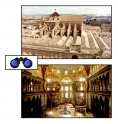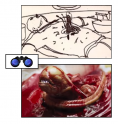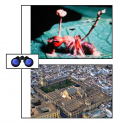When one life sprouts inside another
[ by Charles Cameron — some ugly comparisons, you have been warned — but it is only the exaggerated ugliness that drives my point home ]
.
The first DoubleQuote of three I’m posting here shows two views of sacred sites taken over by conquering religions.
You may have seen this DoubleQuote before — the upper panel shows the Mezqita or Grand Mosque of Cordoba, an extraordinarily beautiful building in the middle of which Spanish Catholics grafted a baroque cathedral, an act of which King Carlos V of Spain said:
You have built here what you or anyone might have built anywhere else, but you have destroyed what was unique in the world
The lower panel shows the Hagia Sophia or Basilica of the Holy Spirit in Istanbul, which was turned into a mosque by Muslim conquerors, and subsequently made into a museum
**
The question this sort of transformation of sacred places — from one faith to another, often by conquest but also on occasion by commercial transfer or simple generosity — leaves me wondering what it must feel like for those who lose their place of worship, especially in case of conquest. And I should make it clear that my question applies as much to Jews unable to pray on Temple Mount as it does to Christians in Istanbul or Muslims in Cordoba.
By its visual nature, the Cordoban example sticks in my mind, however — the relatively new cathedral sprouting quiute visibly from the ancient mosque.
And so it is that my mind, habituated to seeking visual analogues, stumbled on the disgusting — if brilliant — birth of the alien in Ridley Scott‘s The Alien:
I know: Giger‘s aliens in the movie — and even more so, in the now canonical “chestburster” scene — are hideous, as Ridley Scott himself said, “in the unique manner in which they convey both horror and beauty.”
**
Granted, these comparisons from “fiction” (above) and “nature” (below) to what is now one of the world’s more interesting architectural oddities seem obscene — we are used to the church-in-a-mosque as a tourist attraction, and in its own way a minjor miracle —
— my interest here, hiowever, is in looking at it, not through Muslim eyes, but through the eyes of those Muslims for whom building a church inside what was not only a mosque but one of the most beautiful mosques in the world feels like a grievous insult.
For them, the cathedral in the Mezquita is a blasphemy — the insertion of a polluted form of worship in a place once dedicated to God’s own preferential service. And this is important not so that we can understand the ideation of those who wish to return the cathedal to a mosque and more generally Spain to al-Andalus, but so that we can comprehend the depth and intensity of the associated emotion.
The passion.
Page 1 of 2 | Next page


